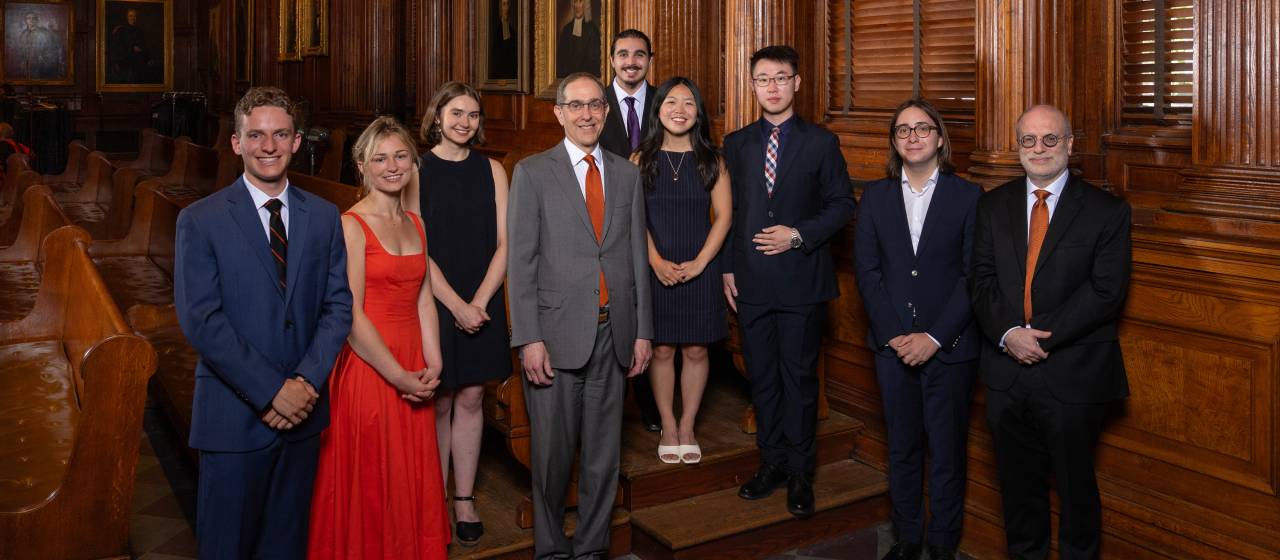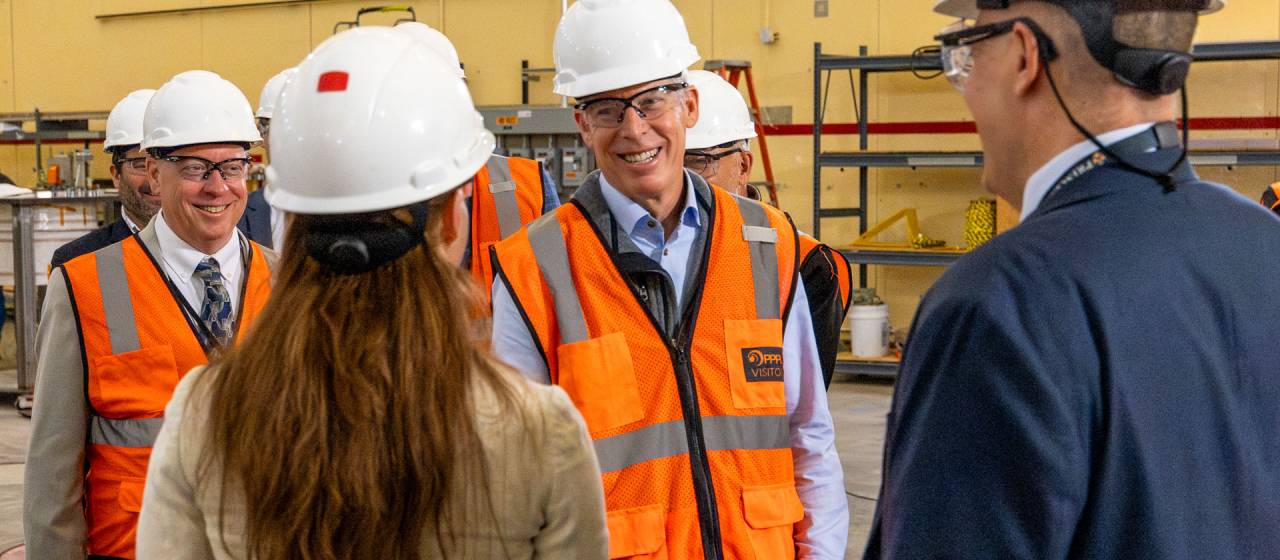Senior Thesis Spotlight: A ‘high-risk, but well-defined’ idea to advance quantum computing
Thomas Verrill has always been good with machinery; in high school he led a group that built an automatic windshield dimmer to cut road glare. But the first time Verrill suited up for the clean room at Princeton’s Micro/Nano Fabrication Center, his hands trembled, and his stomach fluttered.
Wearing a white polypropylene “bunny suit,” goggles and double gloves, he entered a space where the air was stripped of the tiniest particle of dust. Inside was one machine that could spin a photoresistant coating less than a thousandth of a millimeter thick onto a silicon wafer. Another could apply a beam of electrons to create nanoscale patterns in the coating. Despite extensive training and detailed protocol sheets, Verrill was on edge.
“There’s so many different things you need to be careful and precise with, and I have kind of a shaky hand, so that was stressful,” said Verrill, an electrical and computer engineering major from Matthews, North Carolina.
But after shadowing his graduate student mentor, Matthew Bland, and working on his own for several months, Verrill was moving easily from machine to machine, orchestrating work at the cutting edge of quantum technology.
For his senior thesis with adviser Andrew Houck, Verrill designed and fabricated new chips for superconducting quantum computing. The chips use specialized materials to create paths that steer and confine electrons with such precision that the electrons can be used to compute and store information. With more progress in this technology, researchers could solve mathematical problems and investigate natural systems in ways that are impossible with classical computers.
Challenges at the cutting edge: ‘You have to be very strategic’
One of the most difficult challenges of quantum computing is keeping the pieces that store information (called quantum bits, or qubits) in a particular state that allows for calculations. That state is extremely fragile and difficult to maintain for enough time — called coherence time — to allow for a working computer.
Researchers manipulate superconducting qubits by blasting them with microwaves, typically at frequencies of 4 to 5 gigahertz. Houck had speculated that using lower frequencies might produce longer coherence times. But low-frequency systems require larger chips that are challenging to design and could compromise the quality of qubits in ways that are difficult to predict.
The new chips required larger capacitors, leaving less space for qubits, and chips with fewer qubits present limitations for designs and experiments.
“You could try to squeeze more qubits on there by putting qubits closer together, but then electric fields from the qubits would interact more heavily, which is not desired and could lead to lower qubit lifetimes,” said Verrill. “You have to be very strategic about where you put them.”

In a Princeton clean room, Verrill fabricated the chip designs predicted to yield desirable qubit properties.
Using simulation software, Verrill learned to vary the sizes of different components, sometimes making changes as small as bacterial cells, and to tweak the connections between them. He simulated how the design would react to microwave pulses at specific frequencies until he found a setup predicted to yield desirable qubit properties. Only then did he fabricate the chip in the clean room.
While theory suggests that lower frequencies could extend qubit coherence, the idea has not been explored in physical systems, said Houck, the Anthony H.P. Lee ’79 P11 P14 Professor of Electrical and Computer Engineering and the inaugural co-director of the Princeton Quantum Initiative.
“These sort of high-risk but well-defined ideas are the kinds of ideas that I love to give to undergraduates,” said Houck, who himself earned a B.S.E. from Princeton in 2000.
Creativity within vexing constraints
For Verrill, learning to design and fabricate these highly sensitive electronics within a narrow set of constraints has been a frustrating yet fulfilling process that constantly reminds him of what first attracted him to engineering.
“I like the intersection of creativity and physically solving problems,” said Verrill, who also graduated with minors in computer science, music, and music performance. “I really like optimizing for the right parameters and figuring out that something can be done even if the parameter space is kind of strict.”
Verrill has also shown courage and creativity in his musical career at Princeton. He began playing the trombone in middle school and had mainly played classical music until he arrived at Princeton. He joined the music department’s jazz band, the Creative Large Ensemble, after auditioning with a classical piece. Since then, he’s fallen in love with jazz rhythms and improvisation, playing in multiple ensembles and even arranging a piece for the Creative Large Ensemble.
“Classical playing is very focused on refining your technique as much as possible, and while there is that in jazz, it’s more creative,” he said. “You have the freedom to form your own ideas and practice those ideas.”
Since fall 2023, Verrill has hosted a Thursday evening music show, “The Laboratory,” on local radio station WPRB, which he’s described as “full of bubbling genre concoctions and explosive experiments, and the unexpected.”
For his senior jazz trombone recital, titled “Introspection,” Verrill joined four fellow students for “a musical conversation with myself and those around me,” as he wrote on the concert program’s cover. They played numbers by Charlie Parker, Wayne Shorter and Thelonious Monk, as well as an original composition by Verrill called “Monkian.” All the group’s members had moments to shine through improvised solos.
‘He wants to share that passion’
In addition to his research and musical contributions, Verrill has been vital to the quantum research community at Princeton. As a first-year student he joined the newly formed Princeton Students in Quantum. Verrill was so enthusiastic about planning events that he became the group’s co-president for the following two years.
The group now has around 300 undergraduate and graduate student members, and focuses on learning, mentoring and career development. This spring, Verrill led one of the group’s weekly workshops on “How to Win a Quantum Hackathon” and co-organized a “QWest” spring break trip giving students an opportunity to meet quantum industry leaders in California.
“He’s passionate about this science, and it’s clear not just in his work in the lab, but in his extracurriculars,” said Houck. “He wants to share that passion with everybody around him.”
After a summer internship with Rigetti Computing in California, Verrill looks forward to continuing his research as a master’s student at Princeton next year, as well as taking graduate courses in preparation for industry work in quantum computing.
He aspires to improve processes for designing superconducting qubits, or to develop new modes of quantum circuit compilation to help algorithms run more efficiently.
Ever since he first learned about quantum computing, Verrill said he’s been fascinated by the phenomena of superposition, in which qubits can exist in multiple states at once, and entanglement, where the states of two far-flung qubits can become connected.
“It’s this fundamentally new approach to information where you have all these new tools to work with,” he said. “I was confused by it and also excited by it. I just wanted to keep on doing it.”

“I like the intersection of creativity and physically solving problems,” said Verrill, who will continue his research as a master’s student at Princeton next year.
















